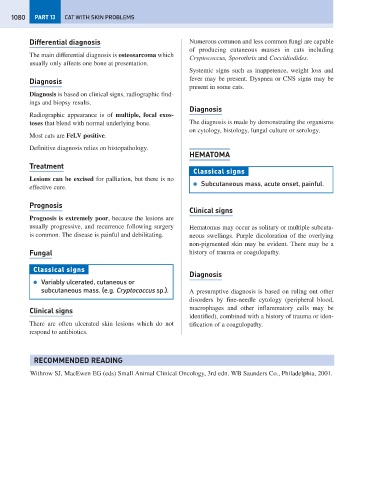Page 1088 - Problem-Based Feline Medicine
P. 1088
1080 PART 13 CAT WITH SKIN PROBLEMS
Differential diagnosis Numerous common and less common fungi are capable
of producing cutaneous masses in cats including
The main differential diagnosis is osteosarcoma which
Cryptococcus, Sporothrix and Coccidiodides.
usually only affects one bone at presentation.
Systemic signs such as inappetence, weight loss and
Diagnosis fever may be present. Dyspnea or CNS signs may be
present in some cats.
Diagnosis is based on clinical signs, radiographic find-
ings and biopsy results.
Diagnosis
Radiographic appearance is of multiple, focal exos-
toses that blend with normal underlying bone. The diagnosis is made by demonstrating the organisms
on cytology, histology, fungal culture or serology.
Most cats are FeLV positive.
Definitive diagnosis relies on histopathology.
HEMATOMA
Treatment
Classical signs
Lesions can be excised for palliation, but there is no
● Subcutaneous mass, acute onset, painful.
effective cure.
Prognosis
Clinical signs
Prognosis is extremely poor, because the lesions are
usually progressive, and recurrence following surgery Hematomas may occur as solitary or multiple subcuta-
is common. The disease is painful and debilitating. neous swellings. Purple dicoloration of the overlying
non-pigmented skin may be evident. There may be a
Fungal history of trauma or coagulopathy.
Classical signs
Diagnosis
● Variably ulcerated, cutaneous or
subcutaneous mass. (e.g. Cryptococcus sp.). A presumptive diagnosis is based on ruling out other
disorders by fine-needle cytology (peripheral blood,
Clinical signs macrophages and other inflammatory cells may be
identified), combined with a history of trauma or iden-
There are often ulcerated skin lesions which do not tification of a coagulopathy.
respond to antibiotics.
RECOMMENDED READING
Withrow SJ, MacEwen EG (eds) Small Animal Clinical Oncology, 3rd edn. WB Saunders Co., Philadelphia, 2001.

